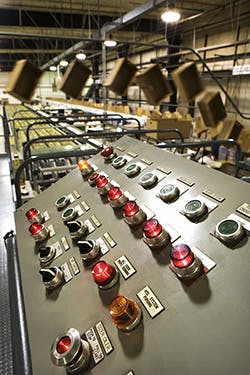Tip of the Week: Don’t Waste Your Technicians' Valuable Time
A large piece of production equipment has all of its controls in a central cabinet. The cabinet is fed by a 40A branch circuit. Many other types of equipment are on branch circuits originating in the panel where that 40A breaker is installed.
The preventive maintenance (PM) procedure for this system includes the step of using a digital multimeter (DMM) to record the supply voltage to the cabinet. Another step involves recording the supply voltage to each of the motors that are part of this system. They range from 5 HP to 50 HP. Three of them are VFD-controlled.
Do you see a problem here? Think about the process of taking a voltage measurement in an industrial setting. Is there any reason to expose a maintenance person to the hazards involved? And what are you going to do with the data?
Voltage measurements taken at the supply of a motor raise issues that require more than a DMM. For example, what’s the power factor when the motor is running? It gets even more complicated with a VFD in the mix (a power analyzer comes in handy, here). But for the purposes of maintenance (as opposed to system optimization), time would be better spent conducting infrared thermography on the motor system.
Consider the issue of measuring the voltage at the supply of the control cabinet. It’s not necessary. If the indicating lights of the individual controllers are on, the cabinet has power. If there’s a reason to know the exact voltage (really, you’re going to trend that perhaps?), install a voltmeter on the panel or have the PLC pick up that voltage and display it somewhere. If this cabinet is for a critical operation, you might want that circuit added to your power monitoring system.
Check your PM procedures to see if they call for any measurements that:
• Are unnecessary (they don’t tell you anything you don’t already know).
• Can be done by remote instrumentation (e.g., panel meter)
• Can be done automatically (e.g., power monitor).
If maintenance personnel don't have to spend time on these sorts of measurements, they will have more time for performing tasks that lead to better uptime numbers.
About the Author

Mark Lamendola
Mark is an expert in maintenance management, having racked up an impressive track record during his time working in the field. He also has extensive knowledge of, and practical expertise with, the National Electrical Code (NEC). Through his consulting business, he provides articles and training materials on electrical topics, specializing in making difficult subjects easy to understand and focusing on the practical aspects of electrical work.
Prior to starting his own business, Mark served as the Technical Editor on EC&M for six years, worked three years in nuclear maintenance, six years as a contract project engineer/project manager, three years as a systems engineer, and three years in plant maintenance management.
Mark earned an AAS degree from Rock Valley College, a BSEET from Columbia Pacific University, and an MBA from Lake Erie College. He’s also completed several related certifications over the years and even was formerly licensed as a Master Electrician. He is a Senior Member of the IEEE and past Chairman of the Kansas City Chapters of both the IEEE and the IEEE Computer Society. Mark also served as the program director for, a board member of, and webmaster of, the Midwest Chapter of the 7x24 Exchange. He has also held memberships with the following organizations: NETA, NFPA, International Association of Webmasters, and Institute of Certified Professional Managers.

